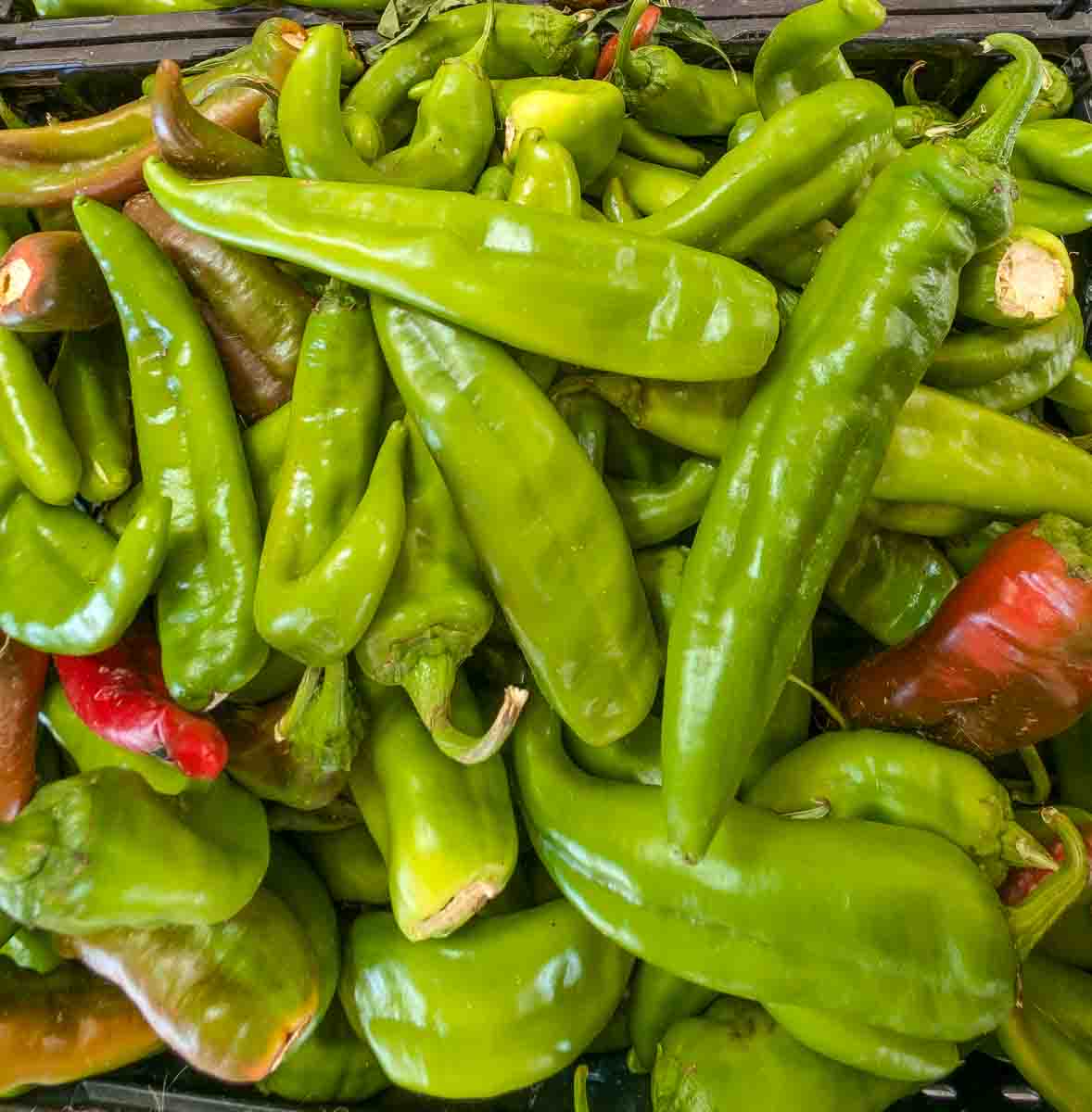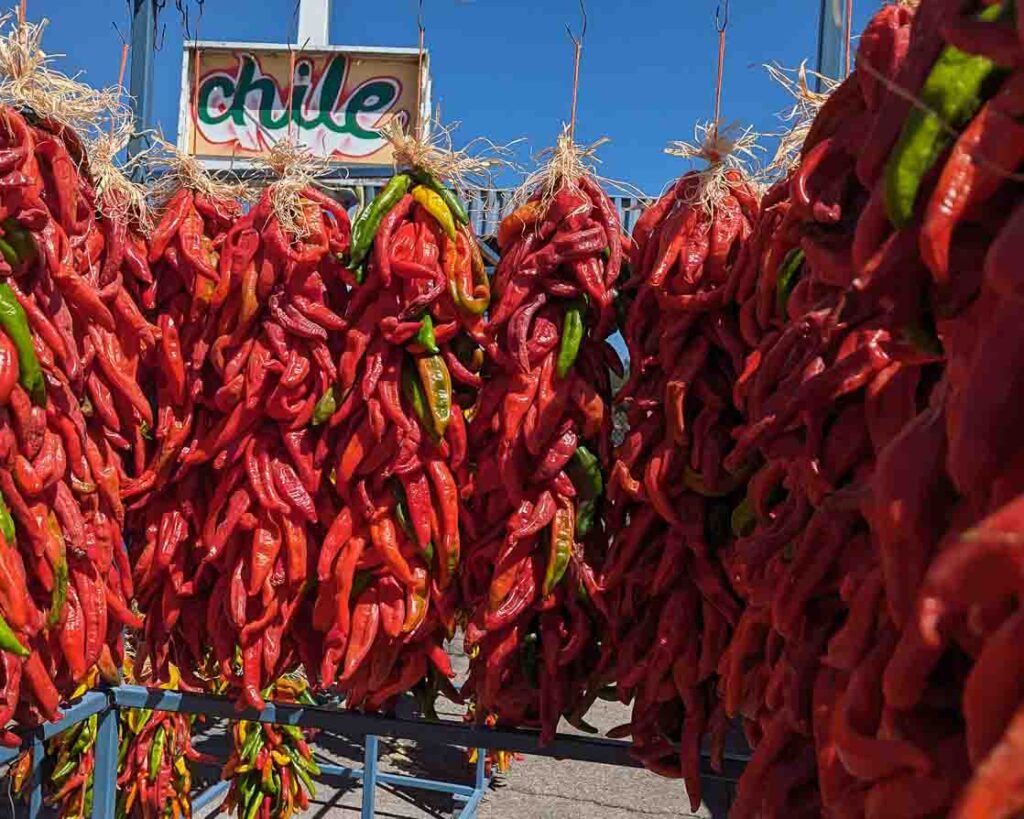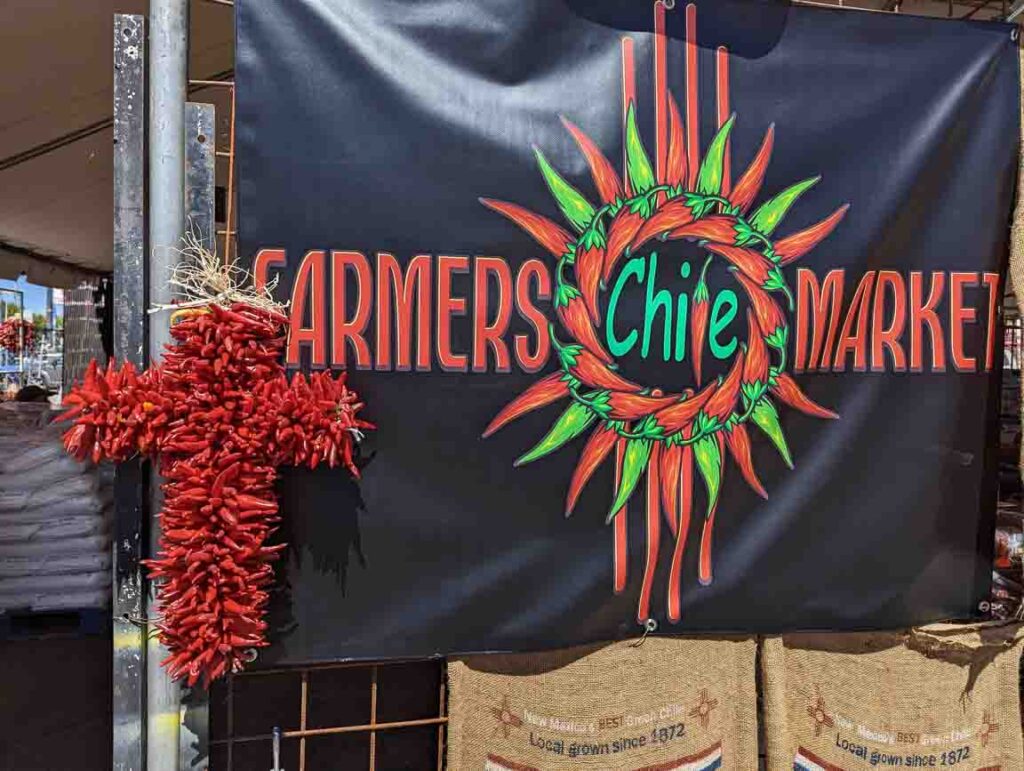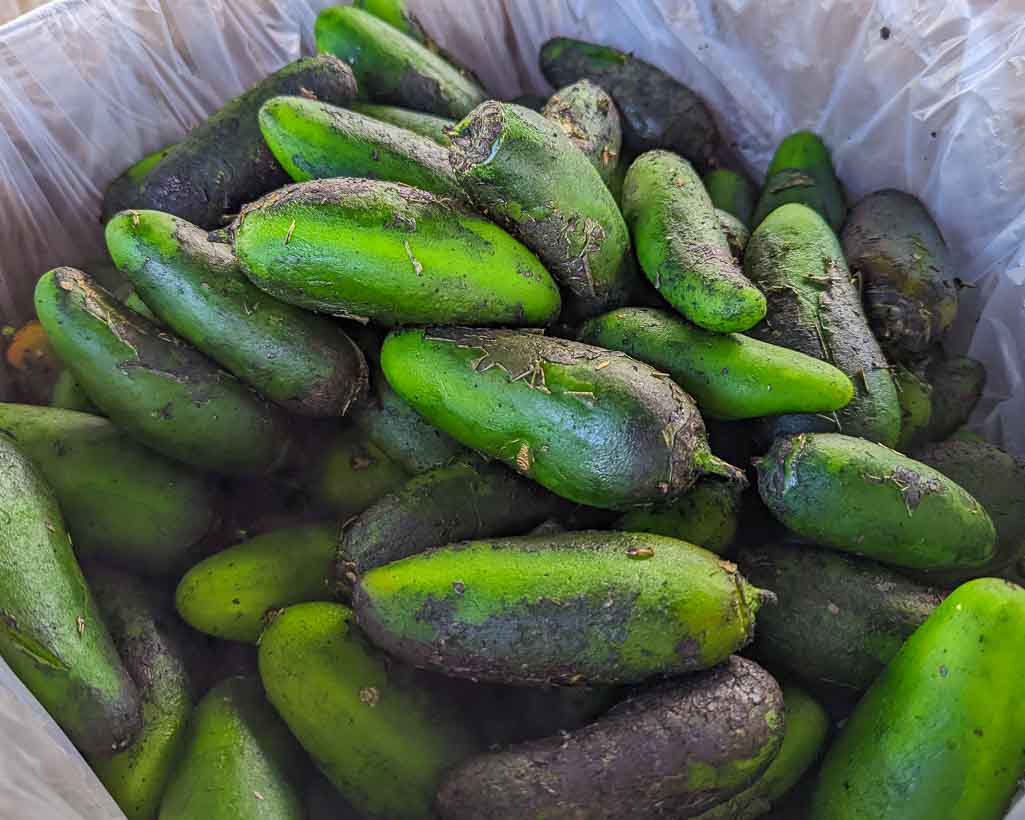Your cart is currently empty!
Old Vs New Mexico chiles

The chili plant is one of the most diverse fruit plants in the world, with varieties of chile coming in all shapes and sizes! Because of the vast diversity, in this post I will be talking only about varieties of chile peppers commonly used in New Mexico and Mexico. In the future I will also talk about other chili peppers I find throughout my travels around the world looking for flavors!
New Mexico Chile
Although it is commonly referred to as Hatch chile, the official name for the green and red chile which Hatch is famous for is New Mexico chile. New Mexico chile has many varieties ranging from Mild to XXX-hot.
Varieties of New Mexico Chile
Mild
Joe E Parker and Numex 6-4 are the two most common varieties of mild chile. Mild chile characteristics are low heat, big, and mostly straight with fat tips.
Medium
Big Jim is by far the most common medium variety in New Mexico, ans was formerly ranked as the largest chile in the world. Another medium-ish chile that is quite famous is Chimayo chile. Finally, a relatively new variety with a bit more heat than Big Jim is Charger. Charger is especially common in the early chile season, as the plants are good for transplanting outdoors after being started in greenhouses.
Hot
The most famous hot New Mexico chile is Sandia chile, which has been popular since being debuted by Roy Harper in the 1950s. Sandia is the most popular chile to tie into ristras! A newcomer into the chile scene, and one of the most popular New Mexico chile varieties nowadays is Ms Junie. Ms Junie is htter and bigger than Sandia, and it a great option for people who like more spicy chile rellenos!
Extra Hot
The classic extra hot varieity in New Mexico is Barker chile. If you go to a chile roaster throughout New Mexico, odds are they have the Barker variety of chile available. Many landrace varieties in New Mexico common in Pueblos around the state are also in the X-hot range, such as Zia chile. Rattlesnake is another X-hot variety that comes in slightly hotter than Barker.
XXX-Hot
We typically jump straight from X-hot to XXX-hot in New Mexico. Why we do it, I don’t know, and dozens of people ask me about it every year. XXX or triple X rolls off the tongue better I guess. If you hear XXX-Hot, odds are the variety is Lumbre chile. Our XXX-hot chile in New Mexico is relative to other chile varieties here. There is a huge difference in heat level between lumbre and superhots like ghost peppers!
Mexican Chile
Going from hot to mild, here are the most well known varieties of Mexican chile.
Extra Hot Mexican Chiles
All chile in this category are hotter than our XXX-hot Lumbre chile in New Mexico. We eat a lot more chile in a dish than other places, so the heat level builds up more.
Habanero
Despite a name evoking Cuba, the Habanero is the preferred choice in Mexico for crafting exceptionally spicy salsas. Its prevalence often means that ultra-hot peppers like Ghost or Carolina Reapers haven’t gained the same foothold. Typically, Habanero salsas are offered separately for adventurous diners rather than being automatically included in dishes.
Chile Tepin (Chiltepin)
Believed to be one of the ancestral chile species, these diminutive peppers deliver an explosive combination of flavor and heat. Their taste profile is rustic and smoky with earthy notes, lacking significant sweetness or fruitiness. Even a small quantity can dramatically increase a dish’s spice level.
Chile de Arbol
Offering a heat level similar to Cayenne, this pepper delivers a substantial kick. Its name, meaning “tree chile,” comes from its characteristically woody stems. These sturdy stems make it popular not only for potent hot sauces salsa picante but also for creating decorative chile strings or ristras in various shapes. This chili pepper is commonly called chile pequin in New Mexico.
Hot Chiles
Serrano
Commonly available in the US, Serranos generally provide more heat than Jalapeños, although their spice levels can sometimes overlap. Compared to Jalapeños, they tend to be less sweet, more earthy, and contain less moisture. Adding one or two Serranos is a popular way to significantly boost the heat of salsas without an extreme jump. Due to their delicate, thin walls, they aren’t usually dried. Caution is advised when handling Serranos and hotter peppers – gloves are recommended to prevent skin irritation.
Jalapeño / Chipotle
Arguably the most recognized Mexican chile globally, the fresh Jalapeño is noted for its juiciness, pleasant fruitiness, and a touch of sweetness that develops upon ripening. Widely available, its ripened and smoke-dried alter ego, the Chipotle, is also common. Chipotle comes in variations: Chipotle Morita, the frequently seen reddish, somewhat soft version, and Chipotle Meco, favored in Mexico, which is smoked longer to achieve a browner, tobacco-like appearance and a more intense smoky character. While not overwhelmingly hot for seasoned spice enthusiasts, both Jalapeños and Chipotles provide enough heat to be satisfying and serve as excellent peppers for gradually increasing one’s heat tolerance.
Other Regional Hot Chiles
Mexico boasts numerous other hot chile varieties specific to certain areas, making them challenging to source outside their home regions, even within Mexico itself.
Mild Chiles
Poblano / Ancho / Mulato
The Poblano is the mild, fresh green chile. When ripened and dried, it becomes the Ancho, which presents very little heat but significant sweetness, often compared to raisins. If the Poblano is allowed to ripen even further before drying, it yields the Mulato chile, which is sweeter still, yet carries a bit more spiciness than the Ancho. These demonstrate how chiles, as fruits, develop sweetness as they mature.
Guajillo / Mirasol
The dried Guajillo, perhaps the most pungent among the milder chiles discussed here, is a staple in Mexican kitchens. Its fresh form, Mirasol (meaning “sun-gazing”), gets its name from its upward growth habit. As a dried chile, Guajillo is fundamental to many Mexican red sauces and is frequently blended with Pasilla and Ancho to create complex, balanced flavors for dishes like tamales or enchiladas. Its heat is generally milder than a Jalapeño but stronger than Poblanos or Chilacas.
Cascabel
This chile offers gentle heat and stands out with its unique appearance. Resembling a small tomato, it retains its round shape when dried, allowing the seeds inside to move freely, creating a rattling sound (hence “cascabel,” or “rattle”). Cascabel contributes a mild earthiness and an uncommon nutty quality that enhances the comforting essence of a dish.
Chilaca / Pasilla
The fresh Chilaca pepper is another relatively mild option common in Mexico, offering a hint of sweetness alongside more noticeable spice and earthiness compared to a Poblano. When dried, it transforms into the Pasilla pepper, a cornerstone ingredient for traditional Mexican red sauces and complex mole preparations.
Comparisons of different chile
Guajillo vs New Mexico Chile
A major difference is that guajillo chile grows up towards the sky, where New Mexico chile typically grows down. Additionally, New Mexico chile is far more diverse than guajillo. Guajillo’s spice level is in between a medium to hot chile in New Mexico. Guajillo is a little less spicy than a sandia chile, the chile most often used to make ristras in New Mexico. If you are making a sauce that calls for guajillo chile, a blend of medium and hot dried New Mexico red chile pods is a great substitution! In case you are looking for some extra heat, be sure to try X-hot Barker or XXX-hot Lumbre red chile pods!

Chile de Ristra vs Guajillo
Chile de Ristra is a chile that really depends on what type of ristra it is. In case it is a ristra made with chile pequin AKA chile de arbol it is quite hot, pushing 30,000 Scoville. In this case, they are not really good substitutes for each other. Chile pequin is small, with a long woody stem that is ideal for tying it into various shapes. In case the chile on the ristra is a large pepper, it is likely a Sandia chile, the traditional hot Hatch chile. This chile is a great substitute for guajillo, because it is a comparable size and just a little bit more spicy.

Hatch chile vs Jalapeno
Jalapenos also have a heat variance depending on the variety, but they typically fall around the Hot scale of New Mexico chile. A Ms Junie chile is right in the range of a jalapeno in terms of heat, while also being much larger. Like Hatch chile, Jalapenos are often ripened up, and red jalapenos have a nice sweetness. They are smoke dried more often than Hatch chile as jalapenos are juicy and don’t dry so well. Jalapenos are often pickled, which is something I like to do, but is relatively uncommon.

New Mexico chile vs Serrano
Serranos are typically spicier than jalapenos, and would rank solidly in the Extra Hot range in New Mexico. Barker chile is comparable in heat to a serrano, while being about twice as large.
Hatch Chile Vs Anaheim peppers
Anaheim chile is a variety famous around the US, but the main reason why is it is typically straight. It is chile that is grown to meet federal grading requirements in order to be sold in grocery stores around the US. As such, the flavor and heat level are less important than the size and shape. If it doesn’t meet these specifications, it can be rejected by the purchaser. Hatch chile is grown primarily for flavor, although we have some giant chile varieties here too. Another defining difference is the culture of chile in New Mexico. We have entire operations devoted to roasting and processing chile here. Anaheim chile is typically grown by huge farms that just farm and send to grocery stores. It’s a commodity product where Hatch chile is a specialty product.
